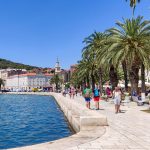As Lea Balenovic/Iva Grubisa/Novac writes on the 17th of April, 2019, Croatian tourism’s current business model is unsustainable and has some serious challenges, according to Emanuel Tutek, a partner at the Horwath HTL consulting house, who stated this at the very beginning of a conference on the challenges of the Croatian tourism sector at Edward Bernays High School, the co-organiser of which was Jutarnji list.
Since 19 percent of Croatian GDP comes either directly or indirectly from tourism, the unsustainability of the system is a more serious issue, he added.
”First of all, our tourism is an extremely seasonal sector and as much as 86 percent of all tourism activities in Croatia take place during the summer months. It’s also problematic that 96 per cent of these activities are realised on the coast and in Zagreb. In translation, this means that we have plenty of room for progress and the development of our tourist offer across the rest of Croatia, as well as the extension of the season. We are well below the European average. For example, if we compare just the peak of the tourist season, ie July and August, there is 10 to 20 times more of a burden on the area and the residents in Croatia than there is in other European countries. Just remember how some of the destinations and beaches look in July or August,” warned Tutek.
He also added that Croatia has plenty of room for progress and development in the quality of the accommodation it provides. The Croatian hotels that, as Tutek says, are the pearl of Croatia’s hospitality, are very much losing the battle with the hotel industry in the rest of Europe, and the alarm that should be enough to wake the country up is also the fact that the revenue made from tourists’ overnight stays in Croatia is less every year.
In addition to this, Croatian tourism is feeling the country’s ongoing demographic crisis bite hard, and has a human resource problem as a consequence. This is, as was explained by Tutek, actually a global problem. However, since the international labour market is far more competitive than the Croatian one is, foreign countries are filling their gaps with Croatian workers. Croatia is, unfortunately, at an unimpressive 100 of 138 countries in the world according to the labour market competitiveness index. An even more concerning piece of information shared by the Horwath HTL consultant was that Croatia is the last and second to last in the world on the ladder of attracting and retaining workers.
”We have no solution. The answers to this can’t just be some lump sums and other initiatives, we need something more fundamental,” he warned. One of the negative factors in each case is the uncompetitive average salary. In nearby Austria, for example, in the hotel sector, wages are about 122 percent higher. Still, the hotel industry here in Croatia has experienced a great discrepancy in numbers, and they have therefore begun to increase employee salaries for the last two summer seasons, which has been a fruitful decision. With the rise in salaries and expenses, revenue also grew.
In addition to the inadequate management of human resources, huge problems are also created by the Croatian tax policy. Property tax, Tutek said, practically doesn’t exist in Croatia. ”We’re the champions of how good private landlords have it. Croatia is a tax oasis,” he claims.
”We want to be competitive, but there are a number of things that we’re not even close to, not even in the wider environment. VAT reduction is certainly important, and there is also the question of consistent policies. It is important for us to have a perception of what will happen in the future at some point, but if the policies constantly change then we can’t have a stable business,” said Sanjin Šolić of the Lošinj hotel group Jadranka.
Davor Lukšić, President of the Lukšić Croatia Group, agreed with him, pointing out that Croatia’s 25 percent VAT rate is very high, and even with a rate of 13 percent there would still be room for progress. “We have to remain competitive, especially now when other destinations in the Mediterranean are making a come back,” Lukšić added.
But if one was to as Croatian Tourism Minister Gari Cappelli, the problem of the high VAT rate is one of the easiest problems to solve in the Croatian tourism industry. The minister claims that the Croatian Government could lower the VAT rate with one decree, bringing it down to 10 or 13 percent, and such a decision is in the government’s plans for the beginning of next year.
”We have a problem with having five-star hotels in two star destinations. First of all, we have to start improving the quality of the destination and spend the whole year measuring what’s happening and only after a few years will we see whether both residents and tourists are happy, as well as service providers and the environment. If everyone is more or less happy, then it makes sense to invest in a four or five-star hotel,” stated Minister Cappelli, adding that in Croatia, it often happens that investments are made in luxurious hotels first, but not in the development of the destination in which it is located.
“Well, we have cases where five-star hotels don’t have sewage systems but septic tanks,” he said. The minister also referred to the initial lecture by Emanuel Tutek about the key challenges facing Croatian tourism. He agreed that there was always room for progress, but he also pointed out that he was tracking the figures daily and that he couldn’t bring himself to agree with all the alarming warnings about the unsustainability of Croatian tourism.
”We’re a strange people, two years ago there were no tourists and they wanted to get rid of me, now there are a lot of tourists, and they want to get rid of me again, the projections of what’s to come in two years keep coming in, and they’re already that I’m shaking in my chair,” said Cappelli, adding that Croatia is spending what it earns and has therefore finally got an investment rating.
”Now the pressure on public finances is being relieved and the taxes on the economy can be reduced slowly,” he said.
If the Croatian tourism association is asked for their opinion on the matter, this is last chance saloon for this tax relief to actually become a reality. Namely, it is anticipated that hotels could reduce the volume of their investments by as much as thirty percent over the next three to four years. ”We want to warn the government that it must not let that happen. We have to invest, but we expect that the government to create measures to encourage that and not just put us off,” said Jadranka’s Sanjin Šolić.
Dubrovnik has experienced not only growth in terms of tourism but also the improvement of infrastructure in recent years, Lukšić believes. However, despite the wild popularity of this particular southern Croatian city, it has multiple problems during the winter season.
”In the last two years, we have extended the [tourist] season and the so called ”congress season” has helped a lot. But we all have to sit around the table and design a strategy for the winter season, which is actually the only problem,” Lukšić said, arousing a grin from Šolić, who, having being on an island, has much bigger problems.
”It’s easy for Dubrovnik. Imagine how it is for us to extend the season! You need to get to the island, the bridge is a problem, the bura is a problem, everything is a problem. We’re less competitive than our colleagues on the mainland whichever way you turn. The Chinese, the Koreans, whoever comes to Croatia, lands in Zagreb, goes to Plitvice, Split and Dubrovnik, nobody comes to us,” complained Sanjin Šolić.
That is why his team sat down together at the table and decided to turn to health tourism for which Lošinj has natural resources, a strategy and a future, said Šolić. Another solution for the development of island tourism is golf. Therefore, a location permit is currently being sought for the construction of a golf course with eighteen holes, with which will be a hotel and villa that will have a total of 800 beds.
”These are the two routes we have on Lošinj. People don’t play golf in July and August because its too hot. During November, December, January, February and March, the weather is wonderful and we’ll fill our capacities that way,” he noted.
Emanuel Tutek welcomed this discrepancy in Croatia’s tourism development strategies at various locations.
”Not all destinations are suffering the same issues. In Dubrovnik, there is a problem with excessive demand, and the quality of the offer needs to be worked on to reduce the number of tourists. In Istria, the offer should be increased. This has, for example, been done in Maistra. Nobody thought it would pay off to build a five-star hotel in Rovinj, but after the construction of the hotel, the rest of the sector was accompanied by the arrival of tourists and the development of the destination.
However, in addition to the respective issues destinations face in Croatia, the eternal problem facing the entire Croatian tourism sector is labour and wages.
”Salaries are a problem, they’re still a base for attracting workers,” said Tutek, agreeing with the CEO of Jadranka, but as he said, it’s difficult to increase salaries because there isn’t enough revenue.
“When the minister sorts us out with less taxes, I’ll give the rest of it in salaries,” he stated.
Make sure to follow our dedicated lifestyle and business pages for much more.
Click here for the original article by Lea Balenovic and Iva Grubisa for Novac/Jutarnji








